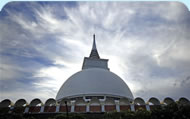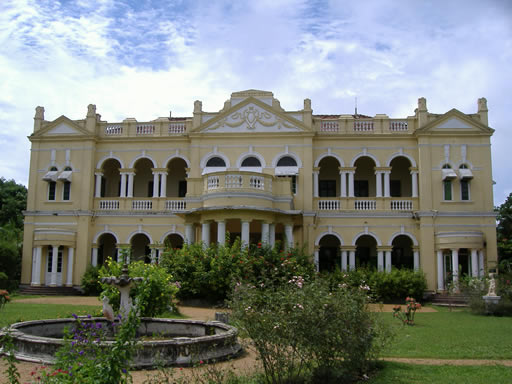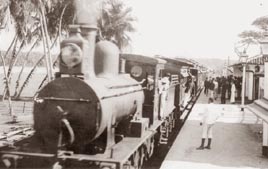KALUTARA

Just over 40km from Colombo, bustling Kalutara is the first beach resort we reach traveling south of Colombo. Kalutara has a huge stretch of fine sand with Wadduwa to the north which is home to the area's top resorts.
The appearance of roadside stalls selling coir rugs, basketware & reed mats signals the entry into Kalutara. As if the tell-tale signs wouldn't do, Kalutara heralds its presence with nothing less than the immense white gleaming dagoba of the Gangatilaka Vihara, immediately south of the long double-span bridge across the Kalu Ganga (River Black).
Kalutara itself divides into Mahawaskaduwa (Kalutata North) where the beach is more scenic, right down to Katukurunda (Kalutata South) It's one of the west coast's largest settlements, but the long stretch of beach north of town remains reasonably unspoilt, dotted with a string of top-end hotels which make a decent first or last stop on a tour of the island, in view of the town's proximity to the international airport.
Kalutara was once an important spice-trading centre controlled at various times by the Portuguese, the Dutch & the British. When the Dutch deserted the bustling spice port at Kalutara, they left behind canals linking the spice plantations. British replaced the inland estates with Rubber plantations. Though estates now produce rubber, traces of the old spice route are seen. By paddling through the tranquil waters of the old canals en route the little known & intriguing Richmond Castle, a few kilometers inland. Today, the bustling town is better known for its coconut palm gardens & for coconut-fibre mats, ropes & baskets.
Just over 40km from Colombo, bustling Kalutara is the first beach resort we reach traveling south of Colombo. Kalutara has a huge stretch of fine sand with Wadduwa to the north which is home to the area's top resorts.
The appearance of roadside stalls selling coir rugs, basketware & reed mats signals the entry into Kalutara. As if the tell-tale signs wouldn't do, Kalutara heralds its presence with nothing less than the immense white gleaming dagoba of the Gangatilaka Vihara, immediately south of the long double-span bridge across the Kalu Ganga (River Black).
Kalutara itself divides into Mahawaskaduwa (Kalutata North) where the beach is more scenic, right down to Katukurunda (Kalutata South) It's one of the west coast's largest settlements, but the long stretch of beach north of town remains reasonably unspoilt, dotted with a string of top-end hotels which make a decent first or last stop on a tour of the island, in view of the town's proximity to the international airport.
Kalutara was once an important spice-trading centre controlled at various times by the Portuguese, the Dutch & the British. When the Dutch deserted the bustling spice port at Kalutara, they left behind canals linking the spice plantations. British replaced the inland estates with Rubber plantations. Though estates now produce rubber, traces of the old spice route are seen. By paddling through the tranquil waters of the old canals en route the little known & intriguing Richmond Castle, a few kilometers inland. Today, the bustling town is better known for its coconut palm gardens & for coconut-fibre mats, ropes & baskets.
Richmond Castle
Richmond Castle, built at the turn of the century in Kalutara, is considered one of the most spectacular architectural works of the period. It was the property of a wealthy landowner turned philanthropist, Padikara Mudali Nanayakkara Rajawasala Appuhamilage Don Arthur de Silva Wijesinghe Siriwardena. The mansion stands majestically at top of a hill, on a 42 acre estate beside the Kalutara-Palatota Road. Once a circuit bungalow for high ranking officers of the British administrative service, today it is a popular tourist attraction, and serves as an educational centre for less privileged children of Kalutara and the vicinity.
It is said that 'Governor George Anderson was requested by the royal family of England to appoint a battalion of 40 soldiers to guard the castle and its occupants. Padikara Mudali, as he was known, had a 12-strong staff known as mudaliyars.
Richmond Castle is a two-storeyed building with 99 doors and 34 windows, decorated with glass panes of exquisite design depicting grape vines. Records indicate that two shiploads of teak were imported from Burma for its construction.
The entire building is characterised by intricate carvings. The timber remains as fresh as at the time of construction. A dancing hall with a stage is another of its features. The architecture shows greater similarity to an English mansion than to an ancient walauwwa.
The gardens which once boasted a profusion of flowers have now given way to trees like coconut, mangosteen, veralu, guava, mango, rambutan and various citrus fruits. The mudaliyar was a lover of nature, and adorned his garden with marble statues, some of which still stand. However he was not happy in marriage, for he was childless. Having ended his marriage, he bequeathed his properties to the Public Trustee for the welfare of the children of the country. He took up residence in a quiet room at the Queen's Hotel, Kandy, where he breathed his last in 1947.
Gangatilake Stupa

It's a lively complex, & a good place to watch the daily rituals of Sri Lankan Buddhism: the offerings to Buddha images are made three times a day. Devotees place food, flowers in front of the images, lighting coconut-oil lamps, trying prayers written on scraps of cloth to one of the Bo trees or pouring water into conduits which run down to water the Bo tree's roots. Outside, a sequence of donation boxes line the roadside, popular with local motorists, who frequently stop here to offer a few coins & say a prayer for safe journey.
Sap tappers

The large number of coconut palms along the coast road marks this as the center of Palm toddy industry. Palm toddy is a favourite among the Sri Lankans, as is the stronger distilled arrack, both of which are found throughout the island. Toddy as well as sweet palm juice, treacle or jaggery are produced from the sap which is collected in earthen pots that are hung at the crown of the palms which have been selected for "tapping" The sap flows when the apex of a virgin frond (flower bunch) is "tapped" by slicing it off & tapping it with a stick to make the cells burst & the juice to flow. This usually starts in about three weeks of the first cut. From then on successive flower buds are tapped so that sap collecting can continue for half a year. The skillful tapper usually ties a ring of rope, a brace around his ankles & shins up the tall smooth trunk two or three times a day to empty the sap pot into one he has tied around his waist. The sap tappers move from one tree to another tree by means of a pair of coconut fibre ropes, one for the feet & other a meter right above it as a grip line for hands, tied at the top of the tall trunk of one tree to the top of equally tall trunk of the next tree. The high in the air horizontal circus rope trick saves the tapper time & energy that would have wasted in the cycle of climbing down one tree & shining up the next tree.
 Source : http://www.tourism.wp.gov.lk |
Richmond Castle is a two-storeyed building with 99 doors and 34 windows, decorated with glass panes of exquisite design depicting grape vines. Records indicate that two shiploads of teak were imported from Burma for its construction.
 |
 Mudaliyar Wijesinghe and his newly wed wife, along with relatives and wedding guests, arrived at the Kalutara railway station by steam driven locomotive. |
The gardens which once boasted a profusion of flowers have now given way to trees like coconut, mangosteen, veralu, guava, mango, rambutan and various citrus fruits. The mudaliyar was a lover of nature, and adorned his garden with marble statues, some of which still stand. However he was not happy in marriage, for he was childless. Having ended his marriage, he bequeathed his properties to the Public Trustee for the welfare of the children of the country. He took up residence in a quiet room at the Queen's Hotel, Kandy, where he breathed his last in 1947.
Gangatilake Stupa

To guard the spice trade the Portuguese built a fort on the site of then Buddhist temple here. The Dutch took it over & a British agent converted it into his residence during the colonial era. The impressive modern Buddhist stupa was built in 1960s has the unusual distinction of being the only one in the world which is entirely hollow. We will be going right inside the cavernously echoing interior. Inside, the cool, echoing walls are lined with a sequence of 74 murals depicting various scenes from the Buddhist Jataka (550 previous births of the Buddha to be - Bodhisattva) tales. The remainder of the temple buildings is situated in a compound on the other side of the road, featuring the unusual Bo Tree enclosures & Buddha shrines.
It's a lively complex, & a good place to watch the daily rituals of Sri Lankan Buddhism: the offerings to Buddha images are made three times a day. Devotees place food, flowers in front of the images, lighting coconut-oil lamps, trying prayers written on scraps of cloth to one of the Bo trees or pouring water into conduits which run down to water the Bo tree's roots. Outside, a sequence of donation boxes line the roadside, popular with local motorists, who frequently stop here to offer a few coins & say a prayer for safe journey.
Sap tappers
The large number of coconut palms along the coast road marks this as the center of Palm toddy industry. Palm toddy is a favourite among the Sri Lankans, as is the stronger distilled arrack, both of which are found throughout the island. Toddy as well as sweet palm juice, treacle or jaggery are produced from the sap which is collected in earthen pots that are hung at the crown of the palms which have been selected for "tapping" The sap flows when the apex of a virgin frond (flower bunch) is "tapped" by slicing it off & tapping it with a stick to make the cells burst & the juice to flow. This usually starts in about three weeks of the first cut. From then on successive flower buds are tapped so that sap collecting can continue for half a year. The skillful tapper usually ties a ring of rope, a brace around his ankles & shins up the tall smooth trunk two or three times a day to empty the sap pot into one he has tied around his waist. The sap tappers move from one tree to another tree by means of a pair of coconut fibre ropes, one for the feet & other a meter right above it as a grip line for hands, tied at the top of the tall trunk of one tree to the top of equally tall trunk of the next tree. The high in the air horizontal circus rope trick saves the tapper time & energy that would have wasted in the cycle of climbing down one tree & shining up the next tree.
No comments:
Post a Comment